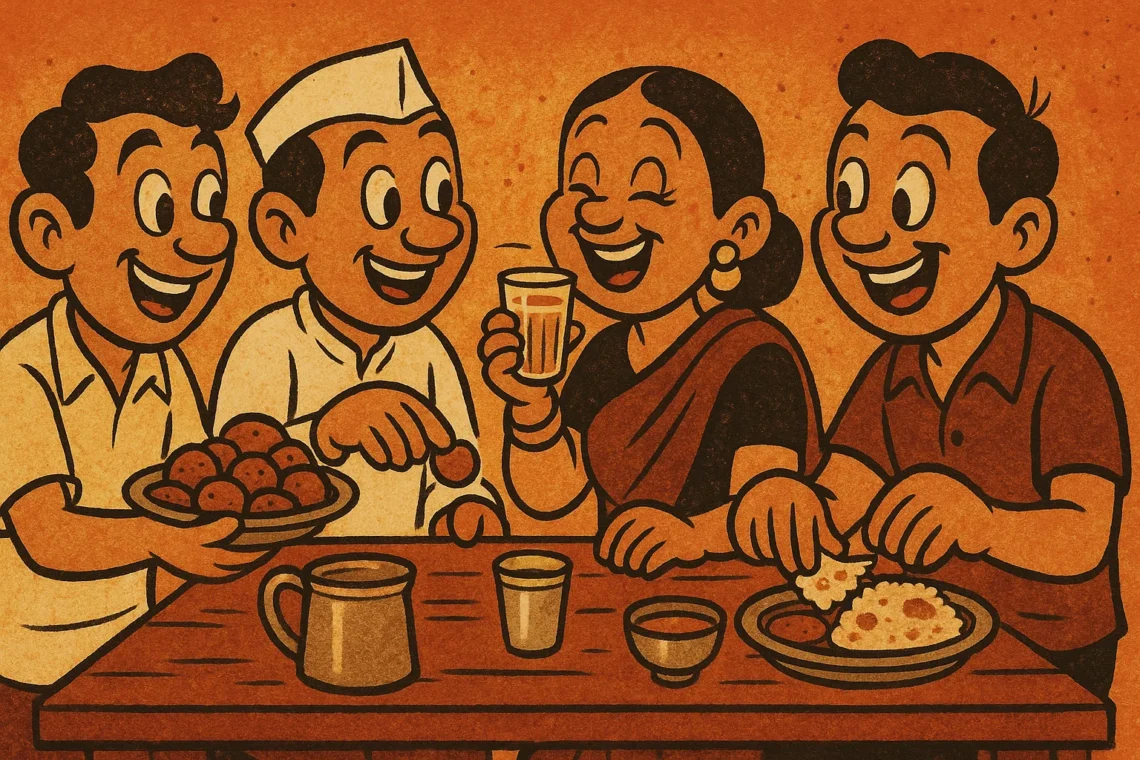There’s something magical about sitting down at a table with strangers, especially in the cozy, bustling atmosphere of a café, a university mess hall, or even a busy food court. When you grab a seat at a communal table, you’re essentially signing up for a brief, unspoken contract of shared space. The rules are simple: you get the table, and they get the space around you. But what happens during those quiet moments of awkward glances, unspoken judgments, and the occasional exchange of words? How do these everyday interactions, centered around food, transform strangers into temporary companions?
The Power of Shared Meals
Meals have always been about more than just sustenance. They are social rituals, rich in history and meaning, creating connections and breaking down barriers. When we sit down with others to eat, we enter into a shared experience. Whether it’s the casual cup of coffee you sip while waiting for a train or the first bite of a delicious biryani in a crowded food court, food becomes the bridge that connects us, even if we don’t speak a word.
At a shared table, the act of eating feels less solitary, even when you’re technically alone. You’re not just enjoying the meal in isolation; you’re engaging with the energy around you. The sounds of forks scraping against plates, the clinking of cups, and the shared smiles over the last slice of pizza—all of these contribute to a sense of collective presence. The meal itself becomes the glue that holds the moment together, even in the absence of conversation.
The Unspoken Social Contract
But there’s more to the shared table than just eating together. There’s a subtle social contract at play. You’re not just sitting next to someone; you’re sharing in their space, in their moment. There’s an understanding that, for the next few minutes or hours, you are both participants in the same temporary world. And, surprisingly, this simple connection has the power to break down many of the walls that might otherwise keep us at a distance.
In most social situations, we might be hesitant to interact with strangers. We hold back, waiting for cues, for permission to speak or make eye contact. But at a shared table, those barriers often disappear. Maybe it’s because the food itself serves as a conversation starter, or perhaps it’s the realization that we are all, in some way, navigating the same social terrain. Whatever it is, it allows for small moments of human connection to flourish. It’s the awkward smile shared over an accidentally spilled drink or the brief exchange about which dish is the best on the menu. These fleeting interactions make us realize that, despite our differences, we’re all just people trying to enjoy a meal.
Breaking Down the Strangeness
What makes shared tables so powerful is that they push us out of our comfort zones and force us to engage with others in an organic way. Take a food court in a busy shopping mall, for example. The long rows of tables lined up side by side, the cacophony of different languages and accents, and the ever-present hum of the crowd all create a sense of collective activity. At first, everyone seems like a stranger, each person caught up in their own world. But as you sit down, you start to notice the small moments that tie you together: the way someone stares thoughtfully at their menu, the shared glance of confusion when the waiter brings the wrong order, the inevitable clink of cutlery as everyone digs into their food.
Over time, those initial moments of strangeness dissipate. The shared space becomes a kind of unspoken conversation, where we acknowledge each other without needing to exchange a single word. And in that simple acknowledgment, we find comfort. The more we break bread with strangers, the less strange they become. We start to realize that the people around us, even though they may come from different backgrounds, are navigating the same human experience: the pursuit of good food, the need for companionship, the search for connection.
The Social Benefits of Dining Together
Beyond the simple human connection, there are tangible social benefits to shared tables. Studies have shown that communal dining fosters a sense of belonging and improves social cohesion. When people eat together, especially in informal settings, they tend to open up, share stories, and engage in more spontaneous interactions. In the workplace, communal dining has been linked to better teamwork and increased collaboration, as employees get to know each other in a less formal setting. In communities, shared meals break down socioeconomic barriers and promote inclusivity. Whether it’s a street-side stall or a grand banquet hall, food brings people together in ways that few other experiences can.
But it’s not just about building relationships in the traditional sense. The act of sharing a meal can also lead to greater empathy and understanding. When we sit down with others, we momentarily leave behind our individual worlds and step into theirs. We listen to the clink of their spoon as they stir their tea, we watch their expressions change as they take a bite of something spicy, and we become part of the shared rhythm of the meal. In those moments, we begin to see each other not as strangers, but as fellow humans, each navigating the same complexities of life.
The Modern Shared Table: A New Kind of Connection
In today’s world, where technology often creates a sense of distance even when we are physically close, the concept of a shared table has taken on new significance. In cities like New York, Berlin, and Tokyo, shared dining spaces are popping up everywhere, from community kitchens to pop-up restaurants, and even virtual meal-sharing platforms. These spaces foster connection, collaboration, and understanding, allowing people from different walks of life to share a meal and, in turn, share part of themselves.
At the heart of it, the shared table is a reminder that, despite our differences, we are all part of something bigger. Whether it’s the communal table at a café or the crowded food stalls of a bustling market, shared meals allow us to engage in something profoundly human: connection, conversation, and understanding. And in a world that can sometimes feel divided, that simple act of sharing a table — of breaking bread with others — might just be the most powerful tool for bridging the gaps between us.
The Transformative Power of Shared Space
So, the next time you find yourself at a shared table, whether it’s in a local café or a busy food court, take a moment to look around. Recognize that you are part of something bigger, something that transcends borders, backgrounds, and languages. The stranger sitting next to you may be just that — a stranger — but in that moment, you share something far more important: a meal, a space, and an understanding that we are all in this together.
Born in Mumbai, now stir-frying feelings in Texas. Writes about food, memory, and the messy magic in between — mostly to stay hungry, sometimes just to stay sane.












